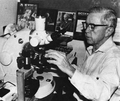Edward B. Lewis facts for kids
Quick facts for kids
Edward Lewis
|
|
|---|---|
| Born |
Edward Butts Lewis
May 20, 1918 |
| Died | July 21, 2004 (aged 86) Pasadena, California
|
| Nationality | American |
| Alma mater |
|
| Known for | Research into genetics of the common fruit fly |
| Awards |
|
| Scientific career | |
| Fields |
|
| Thesis | A genetic and cytological analysis of a tandem duplication and its included loci in Drosophila melanogaster (1942) |
| Doctoral advisor | Alfred Sturtevant |
| Doctoral students | Mark M. Davis |
Edward B. Lewis (May 20, 1918 – July 21, 2004) was an American geneticist. He won the 1995 Nobel Prize in Physiology or Medicine. He shared this important award for his work on how genes control the early development of living things.
Lewis was born in Wilkes-Barre, Pennsylvania. He earned his first degree in Biostatistics from the University of Minnesota in 1939. Later, in 1942, he received his PhD from California Institute of Technology (Caltech). There, he studied the common fruit fly, Drosophila melanogaster.
After serving as a meteorologist in the U.S. Air Force during World War II, Lewis returned to Caltech. He became a professor of Biology in 1956.
His Nobel Prize-winning research used Drosophila (fruit flies). This work helped create the field of developmental genetics. It showed us how genes guide the growth and development of animals. This understanding is important for all living creatures.
Contents
How Genes Control Body Development
Edward Lewis did many experiments with fruit flies. He found a group of genes that act like master switches. These genes produce proteins that tell other genes what to do. They can turn cell processes on or off. This directs how an organism develops.
Lewis also discovered something amazing called co-linearity. This means the order of these control genes on the chromosome matches the order in which they affect body parts. For example, a gene at one end of the chromosome might control the head. A gene at the other end might control the tail. This pattern is found in many animals.
Each of these master control genes contains a special part called a homeobox. This is a very similar DNA sequence found across many different animals. It suggests that these important genes all came from a single original gene.
Lewis believed that by comparing these control genes in different animals, we could learn how both animals and their genes have changed over time.
Understanding Radiation Effects
In the 1950s, Lewis also studied the dangers of radiation. He looked at radiation from X-rays, nuclear fallout, and other sources. He wanted to see if they could cause cancer.
He studied medical records from people who survived the atomic bombings of Hiroshima and Nagasaki. He also looked at records of radiologists and patients exposed to X-rays. Lewis found that the health risks from radiation were much higher than people thought.
He published his findings in science journals. He also spoke to a government committee in 1957. Lewis argued that even small amounts of radiation could have long-term effects. He said that every exposure to radiation added up over time. This idea helped change how we think about radiation safety.
Related pages
Images for kids
See also
 In Spanish: Edward B. Lewis para niños
In Spanish: Edward B. Lewis para niños


